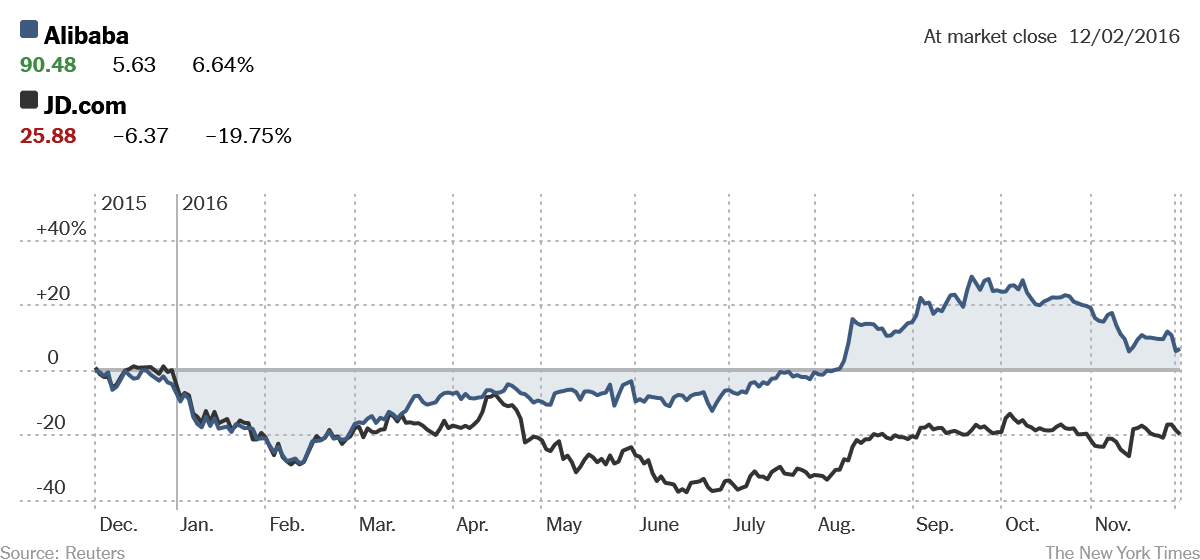Alibaba is one of the largest commerce companies working in the sphere of online and mobile retail. With three key websites: Alibaba, T-mall, and Taobao.com, the company supports its development in China. In addition, the world-renowned website Aliexpress.com offers online shopping services to customers around the globe.
While the company does not sell specific products or regard the operation of an online store as a priority, it focuses on building a large marketplace for merchants to sell their products to either businesses or consumers. If comparing Alibaba to eBay or Amazon, the distinction lies in Amazon focusing predominantly on business-to-customer operations, while eBay is a customer-to-customer commerce website (Dixit and Sinha).
One of the key strengths exhibited by Alibaba is the in-depth understanding of the needs and demands of the Chinese marketplace, handling of the complicated policies and regulations, and the ability to work with the government on a variety of levels.
The key focuses for Alibaba are the expansion of the global market for exploiting increased levels of social capital and merging into more efficient business units by acquiring new firms. As reported by Mozur in the New York Times article, Alibaba showed immense growth in the past couple of years despite the fact that the Chinese economy experienced a slowdown.
With regard to internal strategy, the company achieved considerable success with its new cloud computing services, which Chinese businesses are currently using for increased computer power. As for the company’s external strategy, Alibaba continues to expand the range of available products and involve merchants who sell items that will not only be popular in China but also worldwide.
When exploring the internal and external strategies undertaken by Alibaba, the article highlighted the differences between the opportunities and challenges the company may experience in the future. Regarding the opportunities, the company has a chance to succeed as a result of global expansion and the acquisition of new firms. However, the Chinese business environment limits Alibaba’s capabilities in the internal market due to stiff competition and the decline of the economy.
The three key concepts explored in the article include global expansion, the stumbling Chinese economy, and competition in the e-commerce market. With regard to these concepts, Alibaba is currently thriving despite the slowdown of the Chinese economy and is planning to expand its global presence and reach as many customers around the world as possible.
Internal
When comparing Alibaba to JD.com, its main competitor in the Chinese e-commerce market, it is evident that Alibaba is mostly certain of its business capabilities and showed an increase in growth in 2016 compared to its key rival (Figure 1).

For example, the company’s gross merchandise volume increased by 24% in comparison to that of the previous year. This level of increased performance is now considered to be a standard pace of the company’s development.
To manage the internal market operations, the company began to look into other spheres of business in order to survive in the declining Chinese economy. For example, as mentioned in the New York Times article, Alibaba will start offering food delivery services as well as ‘trying its hand’ in the sphere of entertainment. Moreover, the company is looking to improve and develop its cloud computing services in order to deal with the primary competitors in the internal market.
Despite attempts to capture new markets and create new business opportunities in the internal economy, the company is still at risk of failing. For example, in the sector of cloud computing, Alibaba is currently unable to outperform its rivals, and the domestic challenge created by the Baidu search engine does not allow the company to quickly capture the market in the same way it did with e-commerce.
Moreover, the attempts to capture business opportunities associated with food delivery may cause some issues regarding the drain on earnings due to the fact that many identical food delivery companies compete with each other and try to offer sizable commissions to drivers that deliver meals directly to customers (Mozur).
External
As to the external focus of the company, Alibaba puts an emphasis on international expansion. Despite the fact that the internal market is still the highest priority for Alibaba, in prospect, it has a similar vision to Amazon and wants to expand its reach. One of the most recent steps towards global expansion is the acquisition of Indian firms Snapdeal and Paytm in 2016. To merge into more efficient units that will gain the company more success, Alibaba also acquired a stake in Lazanda, one of the largest e-platforms in Southeast Asia. This decision made by the company’s management makes sense since Lazanda is constantly expanding the base of its consumers (approximately 200 million Internet users) (Team).
The profits from the Chinese market could provide support for the company’s global expansion, and, with the help of foreign investors, the company may acquire sufficient capital for further business operations. To conclude, Alibaba is currently on its way to capturing the global e-commerce marketplace, although there is a number of internal and external factors that may create some barriers for the company and limit its competitive capabilities.
Works Cited
“Alibaba.com vs JD.com 2016” n.d. 2016. Web.
Dixit, Shailja, and Amit Kumar Sinha. E-Retailing Challenges and Opportunities in the Global Marketplace. Business Science Reference, 2016.
Mozur, Paul. “Alibaba Reports Growth, Even as China’s Economy Stumbles.” New York Times. Web.
Team, Trefis. “Why is Alibaba Expanding Beyond China?” Forbes. Web.